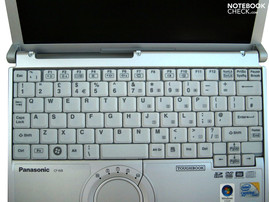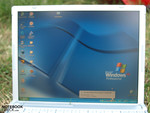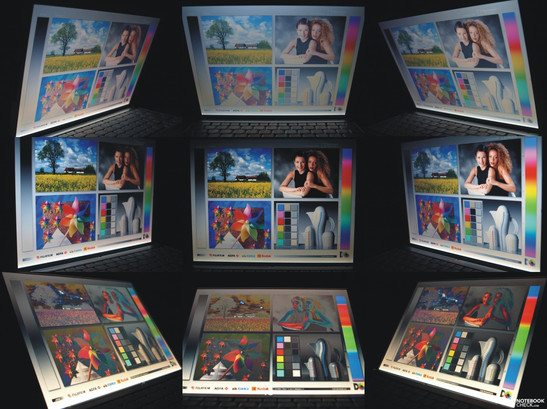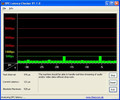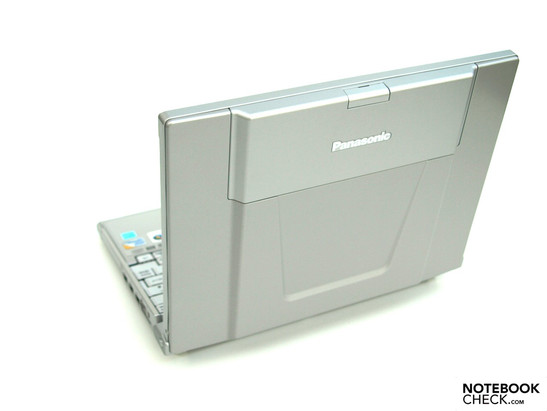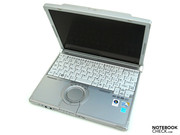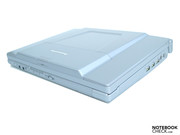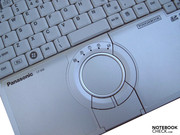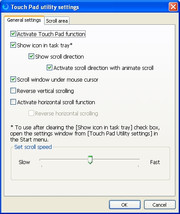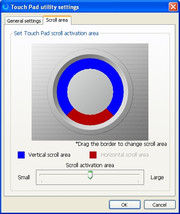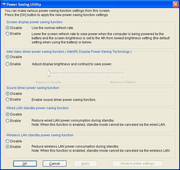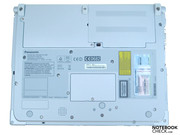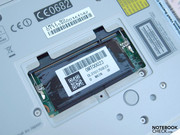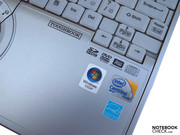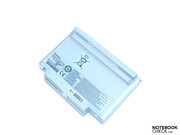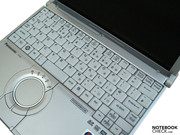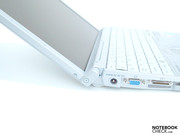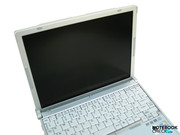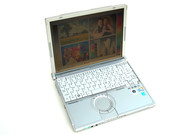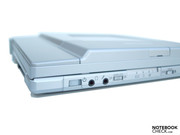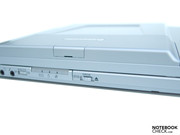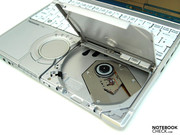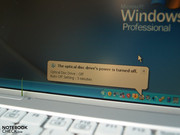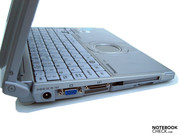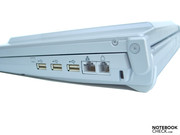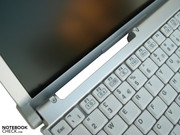Review Panasonic Toughbook CF-W8 Notebook
Business Ruggedized.
Panasonic wants to collect points from their customers with an especially stable case that allegedly protects the Toughbook CF-W8 against several damages. Of course, the communication alignment doesn't come too short in this ultra-mobile device for business clients. Panasonic has also kept a matt, and in view of this, suitable VDU workstation in mind. To what extent the Toughbook CF-W8 can also convince in our test is clarified in the following review.
Panasonic Computer Products Europe are specialized on manufacturing especially stable and resistant notebooks. These are, according to the manufacturer, tested in elaborate test procedures in extremely true to life circumstances, whereas a special weight is put on "Mobility, technical superiority and convincing resistance".
Panasonic categorizes its notebooks in view of resistance as full-ruggedized, semi-ruggedized, and finally, business ruggedized. The CF-W8 belongs to the last category. What this means in regards to drop, spill and pressure resistance in detail, will be comprehensively described in the following categories.
Case
Opposing the trend to build extremely thin notebooks, the rather massive case for a 12.1 inch device struck us right away after unpacking it. This is also confirmed after measuring it. With this, it belongs to the front runners with a construction height of 48.3 millimeters. Because Panasonic has selected a display in a 4:3 size, the depth of 214 millimeters applies, and the breadth of 272 millimeters turns out accordingly. However, not only the massive size has an influence on the device's stability but also the choice of materials. The manufacturer states that the enabled notebook should be able to swallow drops from a height of up to 76 cm on the its bottom and drops of up to 30 centimeters from other angles in a disabled state, whereas the manufacturer has tested it in 26 different angles, due to the use of a magnesium alloy. Pressure loads of up to 100 kg/f, that correlates to 980 Newton, aren't supposed to be a problem for the CF-W8, either. Because we handle our prototypes with care, we didn't reproduce these strains.
Those who come to the conclusion that the CF-W8 has to make a plump impression already due to its construction, are wrong. Moreover, the silver-colored surfaces give it a certain elegance.
The surface feel is pleasant due to the magnesium alloy. Also, the slightly beveled design with a lower construction height along the front edge makes ergonomical typing possible.
As expected, the torsional stiffness and pressure test turned out by and large to our satisfaction. The only weak point was shown under point pressure on the right wrist rest, underneath which the optical drive is found.
The opening angle is restricted to ca. 140 degrees due to the angled hinges fastened on the display. The hinges may appear small but they do a good job. The display barely teeters after adjusting the opening angle and they handle even shaky work surfaces (train journey) perfectly. Panasonic has omitted a transportation closure but, vice versa, the grip of the hinges is also sufficient to keep the notebook closed. But you shouldn't consider trying to adjust the opening angle single-handedly.
Primarily, the innovative position of the optical drive jumps at you. It's opened upwards via a slider on the front edge and enabled at the same time. Closing the DVD drive without a data carrier, disables it after a few minutes to save power. This solution is pleasing in view of operation. Unfortunately there are disadvantages in regards to the right palm rest's pressure resistance, as already mentioned above.
Additionally found on the front edge are the power slider, which lights up green at activation, the headphone and microphone socket, the WiFi switch and Status LEDs for ECO mode, battery and optical drive.
The left side accommodates a VGA port, a docking port, a PC card slot and a SDHC cardreader. The compatible mini-port replicator can be connected to the docking port, which extends the interface supply by 4 USB 2.0, and simplifies the fast connection to an already existing work surrounding with a VGA and LAN port.
On the right there are three USB 2.0 ports, LAN (RJ-45) and a modem connection (RJ-11). The rear has to kept free from interfaces due to the opening mechanisms. A narrow gap above the keyboard's left becomes visible when the battery is removed.
Basically, the connectivity is, in view of the size, good and the distribution can be called felicitous as all potentially permanently occupied interfaces are found more in the rear of the side edges.
The Toughbook CF-W8 can be connected to the Intel 82567LM Gigabit Network connection (10/100/1000MBit) LAN via a cable. In places with a poor infrastructure, the modem connection (RJ-11) might just make internet access feasible.
Aside from an Intel Wireless WiFi Link 5100 AGN (abgn) module there is also Bluetooth 2.0+EDR available, for wireless communication.
Optionally, but not in our prototype, the CF-W8 can also be attained with an UMTS/HSDPA (Gobi) broadband modem for fast wireless internet connections. Equally optional, a fingerprint reader can be selected, whereas you have to then waiver on the Bluetooth module.
We found a printed product description, a modem cable, the Panasonic Wireless WAN (HSPA) SW included in the prototype's package. The long standard warranty of 36 months - with exception of expendable items such as the battery - deserves a special mention.
Microsoft XP Professional with Service Pack 2 (in English) was preinstalled on our prototype. But the CF-W8 is also available with Windows Vista Business Service Pack 1. Various preinstalled utilities support the user in the device's setup, operation and maintenance: Battery tools, the PC Information Viewer, electronic manuals, the Fan-Control Utility, the Icon Enlarger (a magnifying utility), tools for the optical drive (drive letter assignment and energy savings configuration) and the Power Saving Utility.
Input Devices
First of all: Because the prototype came to our lab with an American keyboard layout, we needed a certain accommodation period, as we're used to a different language layout. However, afterwards we could touch-type accurately and easily. The keyboard takes up the whole case width, but although the alphanumerical keys with an effective side length of ca. 13 millimeters are very generous for a device with these dimensions, they're still sometimes too small for larger hands. The enter key is only single-rowed and the space bar with an effective width of 45 millimeters a bit too short. The arrow key grouping has been nicely solved, though. Considering the tight space conditions of a 12 incher, the key layout and key size have been well chosen.
You can be satisfied with the mechanical traits of the keyboard, anyway. Not even the slightest deflection is noticed anywhere, typing is pleasantly quiet and the stroke length and pressure point of the single keys are pleasant, whereas individual preferences are decisive here.
The touchpad bids an innovative circular design with an adjustable scroll zone (rounded along the edge) via software, but which hasn't been visibly marked. The mouse could impress with its gliding traits, precision and response.
The correlating keys also respond over the whole extent perfectly and work quietly.
Once again, a special emphasis has been put on sturdiness of the input devices. Hence, keyboard and touchpad are splash water proof. According to the manufacturer, up to 0.2 liters of liquid can be conveyed outwards and can't damage anything due to a uniquely conceived drainage system - we also didn't check this.
Display
Panasonic has equipped the CF-W8 with a matt display surface, appropriate for a business device. The 12.1 inch LCD supports a maximum resolution of 1024x768 pixels (XGA). With this, we've had the first 4:3 display in our lab in a long time. For office applications, which usually need the vertical height, the somewhat narrower and higher formats sometimes have an advantage. The maximum resolution is, in consideration of size, alright.
The CF-W8 reaches its maximum brightness of 166.1 cd/m2 in the center display sector. From there, the brightness decreases in all directions, whereas we established merely 130.9 cd/m2 in the lower left sector, in the end. A still acceptable illumination of 79% results from both of these values. The display reaches an average brightness of 147.4 cd/m2.
The non-glossy Active Matrix (TFT) color LCD can be worked with comfortably even adverse light conditions... However, at use in direct sunlight, a bit more brightness would be desirable.
Merely an average contrast value of around 109:1 results due to the fairly high black value of 1.52 cd/m2 and the maximum brightness, measured in the center sector.
| |||||||||||||||||||||||||
Brightness Distribution: 79 %
Contrast: 109:1 (Black: 1.52 cd/m²)
Looking subjectively at various bright screen backgrounds on the Toughbook CF-W8's display, there were barely any up to only slight shadow building, depending on the viewing angle.
The test for the maximum viewing angles turns out very good horizontally. The optimal tilt and thus viewing angles are considerably lower on the vertical plane. The colors appear saturated and the displayed image focused.
Panasonic tries to provide a balanced relation in regards to performance and battery life. In our opinion, they've managed to do this quite well. Let's first take a look at the system components.
Das Toughbook CF-W8 nutzt die Centrino-2 vPro Technologie. Als zentrale The Toughbook CF-W8 uses the Centrino 2 vPro technology. An Intel 2 Duo SU9400 (1.40 GHz, 3 MB L2 Cache, 800 MHz FSB) processor (-> manufacturer's information) is employed as the central computing unit. This two-core processor, which is manufactured in a 45nm lithographic process, has been developed especially in consideration of low power consumption. With only a power loss of 10 watts, it's significantly under the consumption of the comparable Core 2 Duo T5270 (1.40 GHz, 2M Cache, 800 MHz FSB) , which needs 35 watts, in view of performance.
Intel's GMA 4500M HD graphic chip integrated into the GS-45 chip set is responsible for pixel computing. This, however, doesn't have a dedicated graphic memory, but borrows a dynamic part from the main memory instead. The GMA 4500M HD supports DirectX 10.0 and can unburden the processor at HD video rendering with its integrated video decoding capabilities, but it hasn't been developed for 3D-biased applications, such as current computer games. Computer games actually don't really belong to the main application field of a business notebook designed for mobility and stability. For further details about built-in graphic processors, we refer here to our graphic card comparison and for the performance ranking to our benchmark list of mobile graphic cards.
If you would like to play an occasional game now and again, older and less 3D-demanding games aren't a problem for the GMA 4500M HD, though. In return, modern 3D-biased games run smoothly at best in a low resolution and low details. For details, we also refer here to our editorial: "Computer Games on Laptop Graphic Cards".
There were two gigabyte of system memory (RAM) built into the prototype. According to the manufacturer, the Toughbook is available with a maximum of four gigabytes RAM. Principally, the GS45 would support up to eight gigabytes RAM, but however it seem that such an upgrade is less sensible in view of the other built-in components. The preinstalled Windows XP Professional 32 bits were a sensible and balanced choice for the two gigabytes built-in on the prototype.
A MK1655GSX hard disk of 160GB gross capacity from Toshiba is available as the mass memory. It works with a rotation velocity of 5400 rpm and supplies according performance values, established with HDTune. In order to fulfill the demands put on a business ruggedized notebook, the hard disk is naturally protected against vibrations. It's also fairly easy to access over a maintenance cover on the notebook's bottom.
That Panasonic also has found place for a DVD multi-drive in this 12.1 incher is especially pleasing. The built-in optical drive is a DVD-RAM UJE844S from Matchita.
System Information Panasonic Toughbook CF-W8
As to test the performance capabilities, we have used a few synthetic benchmarks and found that the Toughbook can very well keep up with similarly equipped devices in view of efficiency, as a look on our benchmark list confirms. Initially, we wanted to pick out the Acer Travelmate 8371 Timeline notebook, a 13 inch device also with an SU9400, GMA 4500 HD and a 5400 rpm hard disk. It has an additional two gigabyte RAM, so a total of four gigabytes, but can't use this advantage completely – probably because of the resource devouring Windows Vista Business 32 bit, which uses four gigabytes of RAM only inefficiently, due to architecture-specific details.
With the same configuration as the Travelmate 8371, but with an SSD mass memory and preinstalled Windows Vista Home Premium 64 bit, the Dell Adamo Thirteen takes the challenge. First in the Cinebench tests could the Adamo overtake the Toughbook CF-W8 slightly with +17% in single-rendering, +11% in multi-rendering and +13% in shading.
Subjectively, you can altogether be satisfied with the Toughbook CF-W8's application performance. Office and internet applications run smoothly and without big delays so that it can be spoken of a solid, target-group suitable application performance.
| PCMark 05 Standard | 3097 points | |
Help | ||
| 3DMark 2001SE Standard | 4641 points | |
| 3DMark 03 Standard | 1714 points | |
| 3DMark 05 Standard | 1159 points | |
| 3DMark 06 Standard Score | 559 points | |
Help | ||
Emissions
System Noise
Subjectively, the Toughbook wasn't conspicuous in idle mode or at use with low load. There is only a consistent, quietly singing, whirring sound audible - but only if you move your ear accordingly close to the fan. This applies to the standard fan settings with which the evaluation was executed. We recorded a maximum of 31.2 dB(A) in this operating condition. Selecting the setting "low" in the preinstalled Fan Control Utility deactivates the fan immediately. You get a quieter notebook with this setting but in return, you have to count with a stronger temperature development. The opposite fan control configuration is also possible. The notebook is kept cooler at the expense of noise emissions in "high".
A maximum of 39.2 dB(A) is reached under load in the fan profile "normal". The DVD drive is considerably louder at data transfer with 47.2 dB(A).
Noise Level
| Idle |
| 30.4 / 31.2 / 31.2 dB(A) |
| HDD |
| 31.4 dB(A) |
| DVD |
| 39.2 / 47.6 dB(A) |
| Load |
| 35.2 / 39.2 dB(A) |
 | ||
30 dB silent 40 dB(A) audible 50 dB(A) loud |
||
min: | ||
Temperature
The case gets quite hot especially on the bottom under load when the fan is set to "normal". The maximum temperature of a high 50.6 degrees Celsius, measured in the center left sector, generally excludes a mobile use on the thighs under high performance demands (for example 3D-biased applications). On the upper side, a peak value of 41.5 degrees Celsius is reached in the center front area (touchpad).
Because this device probably won't be used under permanent full load, we will now look at the evaluations of use in low load. After all, the Toughbook CF-W8 has been optimized for mobile office and internet applications. The temperature development looks a lot better here. Both the upper side, with a maximum of 31.6 degrees Celsius, as well as the bottom, with 36.1 degrees, stay agreeably cool.
(±) The maximum temperature on the upper side is 41.5 °C / 107 F, compared to the average of 35.9 °C / 97 F, ranging from 21.4 to 59 °C for the class Subnotebook.
(-) The bottom heats up to a maximum of 50.6 °C / 123 F, compared to the average of 39.4 °C / 103 F
(+) In idle usage, the average temperature for the upper side is 28.8 °C / 84 F, compared to the device average of 30.7 °C / 87 F.
(-) The palmrests and touchpad can get very hot to the touch with a maximum of 41.5 °C / 106.7 F.
(-) The average temperature of the palmrest area of similar devices was 28.3 °C / 82.9 F (-13.2 °C / -23.8 F).
Loudspeakers
On the bottom there is a small round perforated cover for the, according to the manufacturer, built-in stereo loudspeakers. Their sound is clear with good mids and, as expected of systems without a subwoofer, little bass. The maximum volume is okay, too. You are well-served with the built-in loudspeakers for playing movies and undemanding background music. A sound improvement can be achieved by connecting quality headphones to the 3.5mm headphone socket on the front edge.
Battery Life
The included 6 cell lithium ion battery has a capacity of 59 Wh (10.8 V, 5.8 Ah). It's possible to work with it for a maximum of 684 minutes, that is almost eleven and a half hours without recharging. This runtime has been assessed with the BatteryEater Reader's test, that is with activated energy savings measures, dimmed display and disabled wireless modules. However, we have to note that the minimum display brightness isn't working suitable.
A minimum of a bit over three hours are still possible, anyway. We used the BatteryEater Classic test tool to simulate full load. This recorded 187 minutes for us at maximum display brightness with enabled WiFi modules and energy profile "Desktop".
The Toughbook CF-W8 also proved to have endurance in the practical tests. With 288 minutes in the WLAN test, it's possible take care of internet research or important business correspondence via email for five hours remote from the mains, with the energy profile on "Max. Battery" and adjusted brightness.
At maximum brightness and energy profile "Desktop" you can make a DVD presentation for over three and a half hours or relax watching a movie. Even longer movies are possible with the established 218 minutes.
All evaluations apply to the disabled Economy mode (ECO). If this is enabled, the battery is only charged to 80%. The battery life decreases accordingly in ECO mode. According to the manufacturer, a one-and-a-half-fold longer battery life can then be counted with.
| Off / Standby | |
| Idle | |
| Load |
|
Verdict
With the CF-W8, Panasonic offers a robust 12 inch subnotebook under the keyword "business-ruggedized" The case made of a magnesium alloy doesn't only have a pleasant feel to it, but also contributes significantly to the torsional stiffness and pressure resistance. With the splash water proof input devices and optical drive, the device should also survive the one or other mishap. The impact resistant hard disk also helps to protect sensitive data against loss due to hardware defects.
With a fairly long battery life, well-considered communication solutions and a good application performance, you're well equipped for working on the go. Moreover, the matt, non-glossy display contributes to work ergonomics in adverse light conditions and is therefore suitable for a permanent professional use. However, the display could be a bit brighter for outdoor use.
Basically, the Panasonic Toughbook CF-W8 accomplishes pairing mobility with good battery runtimes, a suitable display unit and communication options, stability and reliability fairly balanced in one device and focuses especially on mobile business users, such as field representatives, managers and frequent travelers. These qualities are, however, reflected very obviously in the price...


 Deutsch
Deutsch English
English Español
Español Français
Français Italiano
Italiano Nederlands
Nederlands Polski
Polski Português
Português Русский
Русский Türkçe
Türkçe Svenska
Svenska Chinese
Chinese Magyar
Magyar





